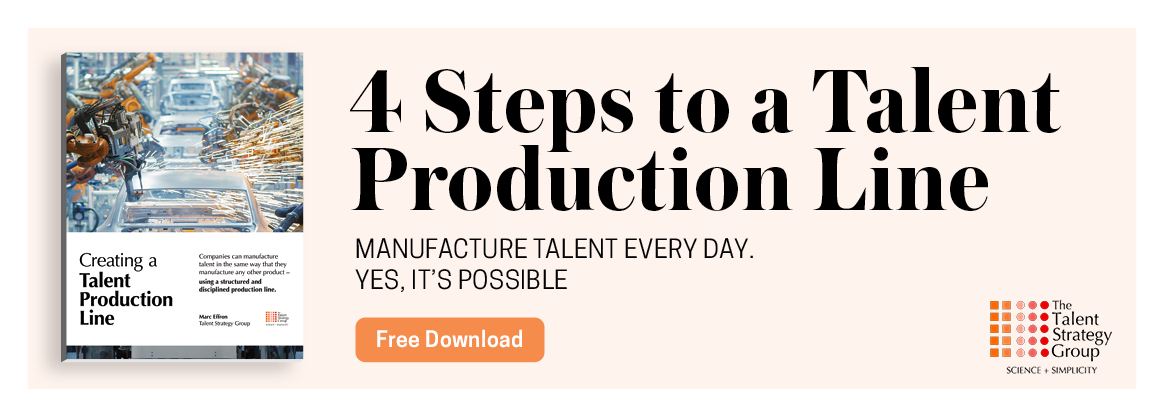Canning the bottom 10 percent of your talent is a no-brainer. High-performing companies focus on those right above them—employees who’ve been on cruise control.
By Marc Effron
You need to fire 10 percent of your talent, and I’m not talking about the bottom 10 percent. Yes, you should can them too. But the group I’m referring to has has hidden for years by delivering “just enough” performance.
These employees perform at the low end of average, with an occasional good year that gives them just enough lift to limp along for one more year. And then one more. If you ranked them against all other employees, they’d never be in the upper 70 percent.
Their performance isn’t so poor that it’s obvious they should be terminated. They hover in the tier just above that. But it would be easy to replace them at the same price, with higher-quality talent, and with relative ease.
Sign up for the monthly TalentQ Newsletter, an essential roundup of news and insights that will help you make critical talent decisions.
They’re often good corporate citizens—they live the values, they’re nice to others. They may be long-service employees who performed well years ago, but who don’t have the capability or mindset to perform at a high level today.
Some possess great institutional memory. They may have a strong network of relationships in the organization and use those relationships to appear more competent than they actually are.
You know you can do better, but instead you treat them like a car tire with a slow leak. You fill it with air once a week because you don’t want to endure the pain and expense of fixing it.
The Next 10 Percent
This group is The Next 10 Percent, and every quarter they hurt your company’s productivity and earnings.
At a time when a few pennies per share shortfall can cost a CEO his job, The Next 10 Percent is the barely hidden secret to better corporate results. Elevate the quality of talent in those roles and you’ll see an immediate improvement in their direct reports’ and peers’ performance.
When we say fire them, we mean it. Do it respectfully. Do it with appropriate notice. Do it with very generous financial consideration. Don’t wait until the next restructuring so it’s easier on you. Give them a big party and a hearty handshake. But since your job is to improve company performance, you need to do it.
If you’re wondering if the business benefits are worth the pain, consider these upsides.
Upside #1: The Performance Benefits Will Be Immediate
We have yet to meet a corporate executive who regretted upgrading the quality of their direct reports. If someone is in The Next 10 Percent, it means that 70 to 80 percent of employees perform better than they do. Unless your selection process is fundamentally broken, your next hire will easily outperform that person.
If you’re concerned that The Next 10 Percenter has unique knowledge that you’ll lose or that must be transferred to his replacement, make sure that their very generous severance package includes having them train their replacement and transfer that knowledge.
Upside #2: You’ll Clear a Path for Others to Advance
No matter what role that Next 10 Percenter is in, someone else can learn more in their role. Their team members are looking up and wondering if the company will ever recognize that this person just can’t do the job. After a bit of wondering, they’ll leave, assuming that the company doesn’t value high performance or development.
Upside #3: You’ll No Longer Be Judged by Their Mediocre Results
You’re being held to a high performance standard and The Next 10 Percenter isn’t helping you deliver results. Your manager knows you need to act on them. Every day you don’t act reflects poorly on your ability to build a high-performing team.
Upside #4: Team Engagement Will Instantly Increase
The Next 10 Percenter may be well liked by peers and coworkers, but they know he’s not the best talent for the job. They may miss him, for a while, but they’ll soon value the high-performing replacement much more.
We know from our research that high-performing companies regularly upgrade their talent and don’t tolerate lower performers very long. They have this shared mindset because they value performance and want the best possible talent in every job. Their executives’ talent philosophy is that average is never good enough.
We also understand that there’s concern and anxiety about making what appears to be a dramatic change. When we offer this advice to our clients, we hear a consistent set of questions, including the following.
Question #1: How do we know who’s in The Next 10 Percent?
You likely know who they are right now but it helps to have quantitative data to support your choices. Performance ratings are the best starting point but likely not at their face value. That Next 10 Percenter may have received “satisfactory” ratings for the past 5 years.
So, if you stack ranked all employees at their level, where would they rank in that hierarchy? It’s likely that many employees received a higher performance rating at least one of those years. Their average rating, even if only slightly higher than theirs, may quickly sort them into the bottom quintile.
You can also stack rank last year’s bonus payouts. You can run a “lifeboat” exercise or conduct a Buy, Sell, Hold discussion.
Question #2: We’ve never told The Next 10 Percent that they’re low performers. Isn’t there’s too much legal risk to terminate them now?
The concern with firing employees is that they’ll sue you for unfair termination. If that’s your primary concern, here’s a great way to avoid paying out lots of money tomorrow—pay out a decent amount today.
We said above that we recommend a respectful sendoff with generous financial consideration and a hearty handshake.
Respect plus money will sharply reduce your risk of a termination ending up in court. Again, this is management advice, not legal advice.
For our friends in countries with works councils or whose management workers are represented by an organized body, you’re obviously tied to those rules. That shouldn’t change your intent to fire The Next 10 Percent, just the process by which you do it.
Question #3: Our talent philosophy or company values say something about showing respect for employees. How is firing The Next 10 Percent consistent with that value?
You can show employees respect and still deliver strong financial results for your company. Respect doesn’t mean keeping under-performing employees in their job. That doesn’t show respect for the company, your shareholders, or your coworkers and doesn’t speak positively about your ability to manage.
Respect should be shown by treating your employees like adults and being transparent with them about their current performance and about the concerns for their future performance.
Why not develop The Next 10 Percent or move them to other roles? You could do either, but it’s highly unlikely that a 20th percentile performer will ever be a sustained 50th percentile performer in the same job or at the same level. In very rare cases, there is such a fundamental misfit that moving someone to a new role will spark high performance. In most cases however, The Next 10 Percent individual is in a job too large for their capabilities.
If you’re committed to building talent internally, you can give that Next 10 Percenter coaching, training, experience, and other developmental activities to try to bring them to the 50th percentile. You may get there. By making that choice, you haven’t invested in helping those at the 65th percentile get to the 85th percentile. Science would say that shift is where you’ll get a better return on your investment.

Question #4: We have a “nice” culture. How could we make this work?
Most cultures are nice cultures and most employees are nice people. They get along with their coworkers and are good organizational citizens. There’s nothing that prevents you from having a nice culture and taking this action.
When people say nice culture, they often mean paternalistic, passive aggressive, not transparent, and not honest. Nice is defined as never sharing bad news or confronting low performance. If that’s your culture, you definitely need to fire The Next 10 Percent, because there’s likely 20 percent of them.
Question #5: Isn’t he the only person who can do the job?
She’s the only person who knows how to do this. He’s the key guy on the project. I can’t find a replacement.
Each of those statements may be true in the short term, but none is a valid long-term excuse for inaction. Unless this individual is the only scientist with experience researching a specific molecule that may create your blockbuster drug, there’s someone else who can do the job.
It might take you 6 months or a year to find a replacement, so start looking today. We don’t advise that you move so fast that you harm the business. But if you’ve said this person is a Next 10 Percenter, every day he’s there, you’re accepting suboptimal business results.
It may sound cavalier to suggest that you terminate The Next 10 Percent of your talent. We believe that better corporate returns are easily found in upgrading performance in these roles and that current talent will never deliver superior results.
By definition, that talent is in the bottom 20 percent of your performance curve, so you shouldn’t be surprised that there’s an opportunity to upgrade. It’s easy to fire the bottom 10 percent. High-performing companies focus on The Next 10 Percent.
Marc Effron is the publisher of Talent Quarterly, cofounder of the Talent Management Institute, and the president of The Talent Strategy Group, which helps the world’s largest and most successful corporations create incisive talent strategies and powerful talent-building processes. He’s also the author of 8 Steps to High Performance: Focus on What You Can Change (Ignore the Rest).


